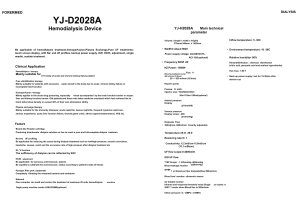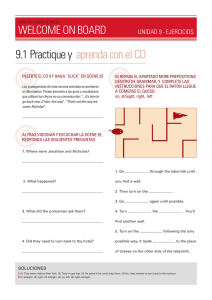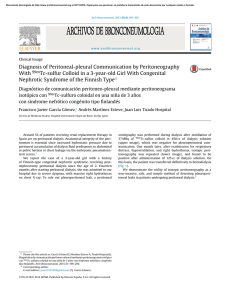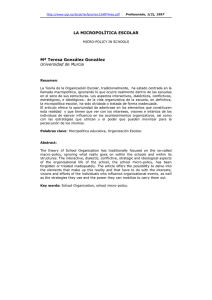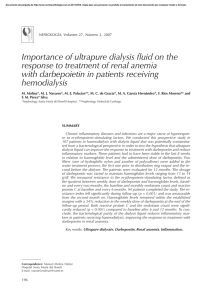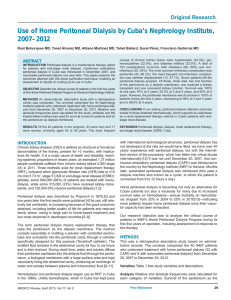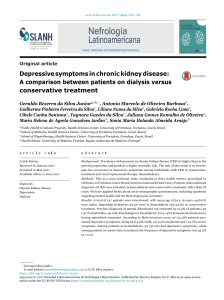Reducing Unit Falls Kaiser Permanente Los Angeles Medical
Anuncio
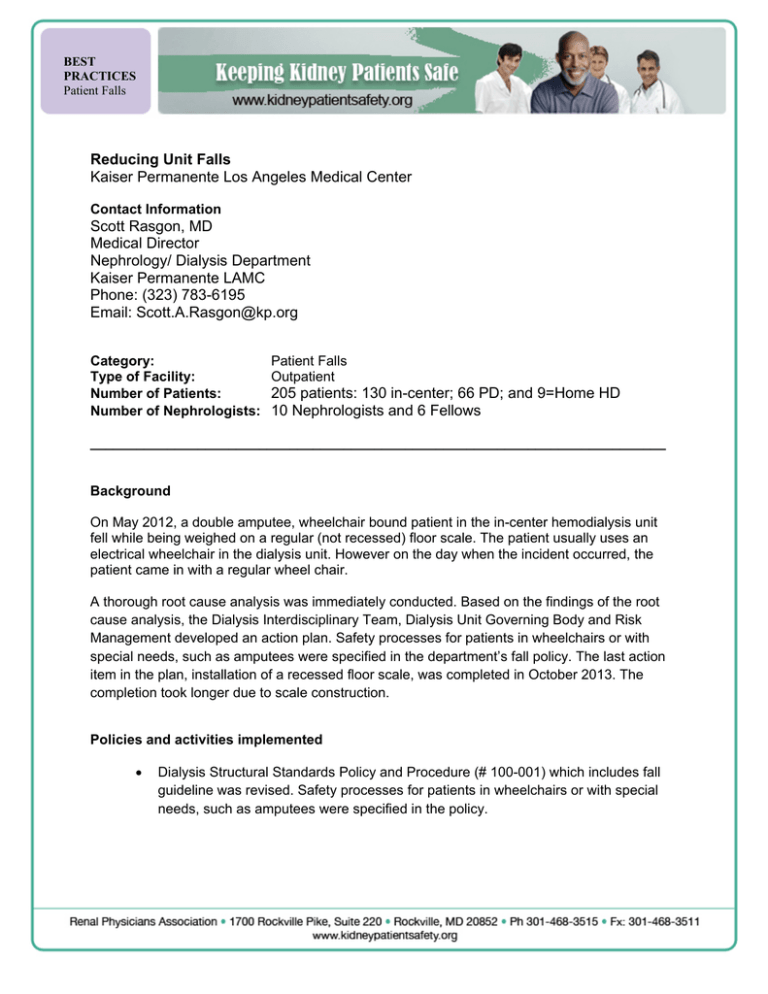
BEST PRACTICES Patient Falls Reducing Unit Falls Kaiser Permanente Los Angeles Medical Center Contact Information Scott Rasgon, MD Medical Director Nephrology/ Dialysis Department Kaiser Permanente LAMC Phone: (323) 783-6195 Email: [email protected] Category: Type of Facility: Number of Patients: Number of Nephrologists: Patient Falls Outpatient 205 patients: 130 in-center; 66 PD; and 9=Home HD 10 Nephrologists and 6 Fellows ___________________________________________________________________________ Background On May 2012, a double amputee, wheelchair bound patient in the in-center hemodialysis unit fell while being weighed on a regular (not recessed) floor scale. The patient usually uses an electrical wheelchair in the dialysis unit. However on the day when the incident occurred, the patient came in with a regular wheel chair. A thorough root cause analysis was immediately conducted. Based on the findings of the root cause analysis, the Dialysis Interdisciplinary Team, Dialysis Unit Governing Body and Risk Management developed an action plan. Safety processes for patients in wheelchairs or with special needs, such as amputees were specified in the department’s fall policy. The last action item in the plan, installation of a recessed floor scale, was completed in October 2013. The completion took longer due to scale construction. Policies and activities implemented • Dialysis Structural Standards Policy and Procedure (# 100-001) which includes fall guideline was revised. Safety processes for patients in wheelchairs or with special needs, such as amputees were specified in the policy. BEST PRACTICES Patient Falls • All dialysis patients shall be assessed for fall risk by a registered nurse (RN) as applicable: o o o o Before dialysis treatment for in-center hemodialysis patients During clinic visit for home dialysis patients With change in patient’s mobility, mentation, elimination, medication regimen or fall history All dialysis patients, after a fall • All patients shall be assisted to/from and on/off the weighing scale. • The following procedure shall be followed for patients using an assistive device such as a wheelchair, a walker or crutches: o o o o • Dialysis staff shall accompany patients upon entering and exiting the dialysis unit. Dialysis staff shall remain with the patient at all times while being weighed on the scale. Dialysis staff shall ensure that the wheelchair is locked and the brakes are on while the patient is on the scale. Dialysis staff shall utilize extra care and caution for patients using manual wheelchairs. Staff compliance was also audited to ensure that above policy was being followed. Staff received training on the new policies and procedures during in-services, and fall guidelines have been incorporated into the staff annual competency review. Patients receive fall prevention handouts, which are available in English or Spanish. Outcomes From 2012 to 2013, Kaiser halved the number of patient falls, from six falls to three. Recommendations • Put together a program/guideline/education for staff and patients regarding fall prevention. • Incorporate fall prevention in the Quality Assurance Performance Improvement Program of the department. Fall Prevention for Dialysis Patients FALLS CAN BE A SERIOUS HEALTH RISK • A dialysis staff member must assist you every time you are weighed and before and after dialysis. • Patients with assistive devices such as walkers, wheelchairs, or crutches, must be accompanied by dialysis staff upon entering and exiting the dialysis unit. LAHED - 1281 (rev11/12) Fall Prevention for Dialysis Patients 1. Make your home safer • Keep your walkways clear. Install good lighting near any stairs. • Use carpet on your floors. If you use a rug, make sure it’s non-slip. When you clean your floors, do not use wax. • Secure wires and cords to the base of the wall with tape. • Install grab bars inside and outside of the tub or shower. 2. Stay physically active • Keep your bones and muscles strong. Keep your joints flexible. Do activities such as walking, swimming, and dancing. Improve your balance and strength with exercise programs like Tai Chi or Qi Gong. • Be physically active for 30 minutes a day on most days of the week. 3. Wear the right shoes • Wear shoes with low heels and thin, firm, non-slip soles. • Shoes with laces or Velcro fasteners provide better support. 4. Review your medicines • Some prescription and over-the-counter medicines can make you feel sleepy or dizzy and increase your risk for a fall. • Review your medicines with your doctor or pharmacist. 5. Have your vision and hearing checked • Changes in your vision or hearing can put you at risk for a fall. • Check your vision and hearing regularly or anytime you notice a change. Prevención de Caídas Para Pacientes en Diálisis LAS CAÍDAS PUEDEN SER UN GRAVE RIESGO PARA LA SALUD • Un miembro del personal de diálisis debe ayudarle cada vez que lo pesen y antes y después de su diálisis. • Un miembro del personal de diálisis tiene que acompañará a los pacientes con dispositivos de ayuda como caminador, sillas de ruedas, y muletas cuando entren y salgan de la unidad de diálisis. LAHED - 1282 (rev12/12) Prevención de Caídas Para Pacientes en Diálisis 1. Haga de su casa un lugar más seguro. • Mantenga despejadas las áreas para caminar. Instale buena iluminación cerca de las escaleras. • Use alfombras en los pisos. Si usa un tapete, asegúrese de que sea antideslizante. Cuando limpie los pisos, no los encere. • Pegue los cables o cordones a la base de las paredes con cinta adhesiva. • Instale barras para sujetarse dentro y fuera de la tina o regadera. 2. Manténgase activo físicamente • Mantenga fuertes sus huesos y músculos. Mantenga flexibles las articulaciones. Haga actividades como caminar, nadar y bailar. Mejore su equilibrio y fortaleza con programas de ejercicios como Tai Chi o Qi Gong. • Haga alguna actividad física durante 30 minutos la mayoría de los días de la semana. 3. Use calzado adecuado • Use calzado de tacón bajo y suelas delgadas, firmes y antideslizantes. • Los zapatos con cordones o cierres Velcro ofrecen mejor apoyo. 4. Revise sus medicamentos • Algunos medicamentos de venta con o sin receta pueden provocarle somnolencia o mareo y aumentar su riesgo de sufrir una caída. • Revise sus medicamentos con su médico o farmacéutico. 5. Pida que le hagan exámenes de la vista y la audición • Los cambios en la vista o la audición también pueden ponerlo en riesgo de sufrir caídas. • Hágase exámenes de la vista y la audición regularmente o en cualquier momento que note un cambio.
